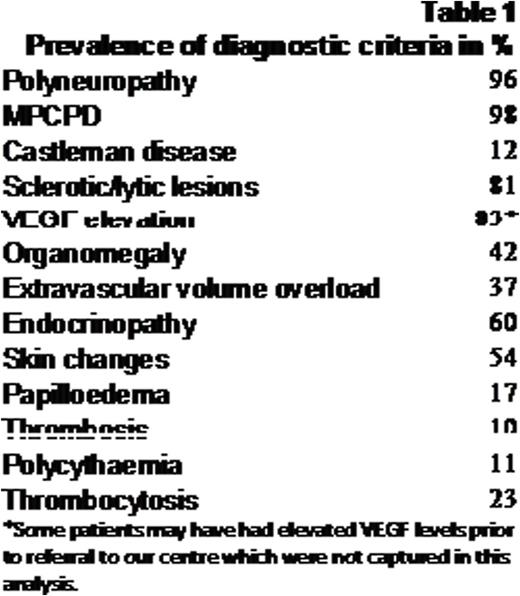Abstract
Introduction
POEMS (Polyneuropathy, Organomegaly, Endocrinopathy, Monoclonal gammopathy, and Skin changes) syndrome is a rare multi-system disorder characterised by a monoclonal plasma cell disorder and peripheral neuropathy in combination with a myriad of other clinical features. Several patient cohorts have previously been described leading to the formulation of diagnostic criteria. For the purposes of establishing a specialist centre in the United Kingdom we collected data of our patient cohort and compared it with previous reports.
Methods
Demographic data for patients currently known to our clinic with an established diagnosis of POEMS (n=52) was extracted from an already existing database. Clinic letters for these patients were retrospectively screened for clinical features, diagnostic criteria, treatments given and response to treatment, occasionally supplemented by review of historical investigation results. The data was collected in a newly established database designed to facilitate future prospective data collection.
Results
Our cohort currently consists of 52 patients from a mixed ethnic background, with a male to female ratio of 4.2:1 (n=42 vs 10 respectively) and a median age of 57; median age at diagnosis was 49. The majority of patients were referred to our centre from across the United Kingdom between 2009 and 2015. The prevalence of diagnostic criteria broadly resembles previously published cohorts (see table).
17 patients received radiotherapy for limited disease while 31 patients underwent autologous haematopoietic stem cell transplant (ASCT); 18 patients received at least one line of systemic chemotherapy. A subgroup review of patients who underwent ASCT showed sustained clinical improvements in 83% of patients reviewed; 61% of patients who received radiotherapy had a documented sustained improvement. Patients receiving chemotherapy showed a more variable response; of note, 4 out of 6 patients treated with a combination of lenalidomide and dexamethasone were documented to have had significant clinical improvement.
3 patients died during the period of follow-up at the ages of 70, 63 and 63, respectively. Death occurred between 4 and 15 months following diagnosis; none of the deceased patients underwent ASCT or radiotherapy.
Discussion
We report the basic demographic and clinical outcomes of a new cohort of patients with this rare condition. Our cohort broadly resembles other previously published reports, as does our experience with therapeutic options. Radiotherapy appears to be effective in stabilising or improving limited disease confined to a solitary plasmacytoma or few lytic foci, while autologous stem cell transplantation achieves sustained improvement in the majority of patients with more diffuse disease. Chemotherapy offers further treatment options for patients not suitable for either of those, with lenalidomide becoming an increasingly promising agent.
Retrospective data collection and the establishment of a database for prospective study will enable us to further investigate this group with a view to expand our understanding of this poorly understood disease.
Yong:Autolus Ltd: Equity Ownership, Patents & Royalties: APRIL based chimeric antigen receptor; Janssen: Research Funding.
Author notes
Asterisk with author names denotes non-ASH members.


This feature is available to Subscribers Only
Sign In or Create an Account Close Modal